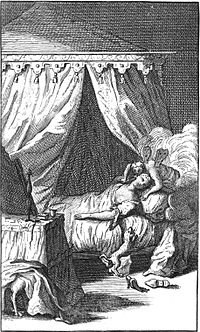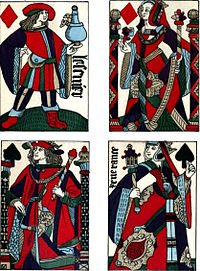
Sir Plume Demands the Restoration of the Lock from The Rape of the Lock by Alexander Pope, 1854 oil painting by Charles Robert Leslie.
The Rape of the Lock is a 'heroi-comical' mock-epic poem written by Alexander Pope. The central character in the poem is Belinda, a young woman from the English aristocracy who, up until the events of the poem, has led a carefree life of leisure and maintained a good reputation. Belinda is considered a great beauty and is particularly admired for the two curly locks of hair which hang down onto her neck. A man known only as the Baron desires to take one of the locks so that he can boast of its possession. With the help of his lady friend Clarissa, he cuts off one of the locks. A fop named Sir Plume is sent to ask the Baron to give it back but the Baron refuses. A fight ensues, during which the lock disappears, rises up into the sky and is transformed into a star.
The poem was inspired by real events. Lord Petre cut off a lock of hair from Arabella Fermor. This led to a feud between the Petre abd Fermor families. Alexander Pope was asked to write a poem about the events, in order to point out how trivial the matter really was and to put an end to the feud.
The Rape of the Lock was first published anonymously in 1712 in two cantos. It was republished in 1714 in an expanded version of five cantos. A final revision was made in 1717 with the addition of a speech about good sense by Clarissa.
The style of the poem imitates epic poetry, such as The Iliad and The Odyssey of Homer and The Aeneid of Virgil. This is done to suggest that the concerns of the aristocrats of Pope's age, the women in particular, were trivial but were treated as if they were of great importance.
A fantasy element is introduced into the poem by the addition of what Pope calls "the machinery", the fairy-like spirits who perform the same function in The Rape of the Lock that gods and goddesses do in ancient Greek and Roman epics.
Many modern readers are likely to find the casual and blatant sexism in the poem and the dedication which precedes it to make for uncomfortable reading.
Summary (1714 version)[]
Dedication[]
The 1714 printing of the poem is preceded by a dedication to Arabella Fermor, the cutting off of whose lock of hair by Lord Petre inspired the poem. Pope thanks Ms Fermor for allowing the poem to be published in its earlier imperfect version and in its new expanded one. He also explains that the new version contains what he calls "the machinery", the spirits called Sylphs, Nymphs, Gnomes and Salamanders, which fulfill the roles taken by deities in ancient epic poems. Pope stresses that all of the events of the poem are fictitious, "except the loss of your hair, which I always name with reverence' and that "the character of Belinda, as it is now managed, resembles you in nothing but in beauty".
Canto I[]

Belinda awakes. Illustration from the 1714 edition.
It is ten o'clock in the morning but Belinda is still asleep. Her guardian spirit Ariel the Sylph causes her to continue sleeping so that he can pass a message on to her in a dream. He takes a form which Belinda will take notice of, that of a handsome young man such as she might meet at a birthday party.
Ariel explains that he is one of the spirits of which Belinda might have heard, that all such spirits really exist and that they were once women. A woman's personality in life determines what kind of spirit she becomes after death. Bad tempered women become spirits of fire called Salamanders, those with "soft yielding minds" become spirits of water called Nymphs,[1] prudes become spirits of the earth called Gnomes and flirtatious women become spirits of the air called Sylphs. Ariel goes on to explain that women can enjoy a close relationship with the Sylphs who protect them, provided that they remain virgins and do not think of mortal love.
The Sylph tells Belinda that he has appeared to her because he knows that something bad will happen to her before the end of the day. However, he does not know exactly what will happen to the young woman. He leaves her with the warning, "Beware of all, but most beware of Man!"
Belinda is woken up when her dog Shock licks her face. The first thing that she sees is a love letter, which causes her to instantly forget the warning she received in the dream.
The first canto ends with a description of Belinda doing her hair and make up in front of a mirror, which is likened to a priestess performing rituals for a goddess.
Canto II[]

1807 depiction of Arabella Fermor, who inspired tha character of Belinda, based on a portrait by Sir Peter Lely.
Belinda goes for a boat trip on the Thames. She is the center of attention, with everybody admiring the two locks of hair on her neck.
The Baron is filled with the desire to take one of Belinda's locks and to show it off. He has called upon all spirits to help him in taking the lock, in particular the Spirit of Love. He has built an altar to Love, made of French romantic novels, love letters and items which he has received from former girlfriends, and has set it on fire.
Taking on his true form, with purple wings and carrying a blue wand, Ariel calls out to all the spirits on the boat on which Belinda is sailing. He details the different functions which spirits carry out, some being in charge of stars and planets, some controlling the weather, some being responsible for nation states and some watching over women. Ariel states once again that something bad is going to happen to Belinda that day, although he does not know exactly what. The spirits watch over Belinda, her clothes and her jewelry. Ariel himself watches over her dog Shock. Ariel warns that any spirit who neglects his duty will be severely punished.
Canto III[]

Cards from a 16th-century French deck.
In the evening, Belinda goes to Hampton Court. She plays the card game Ombre with two men, one of whom is the Baron. Sylphs protect her cards, Ariel sits on the King of Spades, the cards which the other Sylphs sit on depend on their rank in the spirit world. The card game is described as a battle in which the players send out vast armies to fight on the field of the green beize card table. The Baron almost wins but Belinda eventually emerges triumphant.
After the game, the players all drink coffee. The coffee stimulates the Baron's brain, causing him to think of a means of taking Belinda's lock.
Clarissa, the Baron's lady friend, hands him a pair of scissors. Sylphs try to get Belinda's attention by moving her earrings. Ariel attempts to enter her mind. Unfortunately, at the exact moment that the Baron cuts off her lock of hair, Belinda is thinking about a man's love, which means that the Sylphs can do nothing to protect her. A Sylph is cut in two when the Baron cuts off the lock, although, being made of air, he is able to join together again.
The Baron triumphantly declares that he will keep the lock forever.
Canto IV[]

The Cave of Spleen. 1896 illustration by Aubrey Beardsley.
The moment that Ariel is no longer able to protect Belinda, Umbriel the black-winged Gnome leaps into action. He goes down to the Cave of Spleen, an underground realm inhabited by ghosts, demons, people who have been changed into teapots, cauldrons, jars, goose pies and bottles and pregnant men. The realm is ruled over by a Queen who has two handmaidens, an old woman named Ill-nature and a young woman named Affectation. Umbriel tells the Queen that he wants to make Belinda unhappy because doing so will make half the world unhappy too. The Queen gives him a bag[2] full of "Sighs, Sobs and Passions and the War of Tongues" and a bottle full of "fainting Fears, Soft Sorrows, melting Grief and flowing Tears".
Returning above, Umbriel finds Belinda being comforted by her friend Thalestris. He empties the bag over both of them. Thalestris immediately becomes concerned for Belinda's reputation and for her own reputation as Belinda's friend. Thalestris asks her favorite beau, the fop Sir Plume, to ask the Baron to give the lock back. Sir Plume does so, using all the most fashionable slang of the time, but the Baron instead announces his plan to have the lock mounted on a ring.
Umbriel breaks the bottle over Belinda. The young women gives a sorrowful speech, declaring that she wishes that she had grown up in seclusion, never been to Hampton Court and never learned to play Ombre. She says that she should have noticed several bad omens, remembers at last the dream in which she was warned by Ariel and wishes that she had paid heed to it. She complains about how ridiculous her one remaining lock of hair looks now that the other one has been removed. Finally, she says that she wishes that the Baron had taken, "Hairs less in sight or any hairs but these".
Canto V[]

During the fight, the lock is transformed into a star. Illustration from the 1714 edition.
The Baron is unmoved by Belinda's speech and a fight ensues. The fight which is described is partially a war of words, in which gossip and satirical writings cause some participants reputations to be ruined, however, there is physical violence also. Belinda throws snuff into the Baron's face, the Gnomes making sure that it goes into his eyes and nose, and threatens him with a needle. She cries out, "Restore the Lock!" Her friends pick up the cry, shouting louder than Othello cried for, "the handkerchief that caused his pain".
During the fight, the lock disappears. It is searched for but nobody can find it. Some think that it has gone to the moon, where all things which are lost on Earth are said to go. However, the truth is that the Muse, the spirit of poetry, has caused the lock to rise up into the air and become a new star.
Unlike the rest of her hair and Belinda herself, the lock which she lost will last forever. The poem ends with the lines,
- This Lock, the Muse shall consecrate to Fame,
- And midst the skies inscribe Belinda's name.
It is clear that Arabella Fermor is being told that, as a result of her misadventure, a poem has been written which will grant her a degree of immortality.
